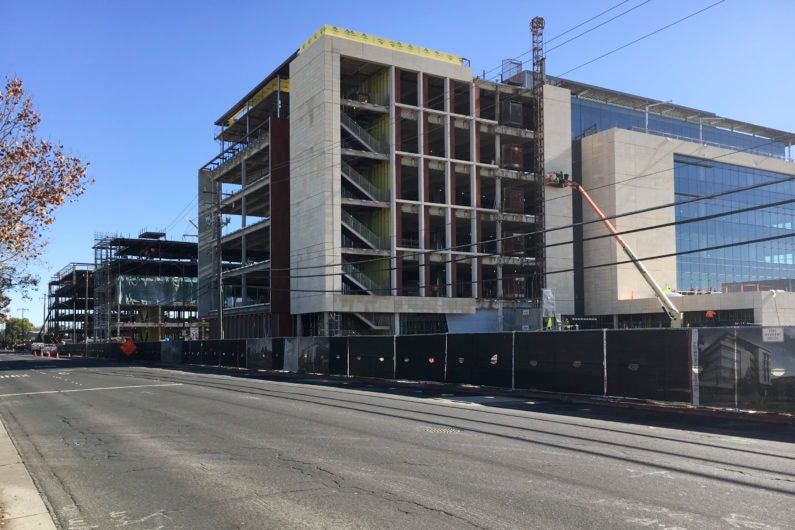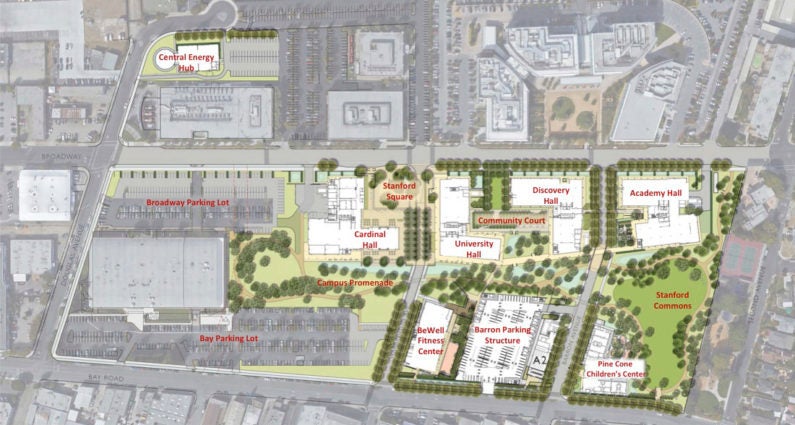Redwood City campus moves ahead
The buildings are taking shape at Stanford's new campus, while a variety of other planning activities are progressing in anticipation of the campus opening in 2019.
It’s beginning to look a lot like a campus at Stanford Redwood City.

This recent photo shows construction at Stanford Redwood City, with Cardinal Hall in the foreground. (Image credit: Kathleen Kavanaugh)
Multistory steel structures of several buildings at Stanford’s new campus are now visible from Highway 101 and nearby city streets. One of the buildings already looks distinctively “Stanford,” with an exterior shell of limestone, terra cotta and glass now in place.
Meanwhile, interior design is moving forward, plans are taking shape for workshops in 2018 to help managers and employees navigate the transition to the new campus, and a variety of Stanford programs for the Redwood City community are being offered.
About 2,700 Stanford employees are expected to work at Stanford Redwood City after it opens in 2019. The new campus will bring together employees in units that provide critical support to the university’s mission but are currently scattered in a variety of locations both on and off the Stanford campus, while also allowing the university to keep academic programs concentrated at Stanford as they evolve and grow.
Progress on construction
The 35-acre Redwood City campus is located between Broadway and Bay Road, not far from Woodside Road. Demolition of existing structures on the site started in December 2016, followed by a groundbreaking ceremony in May.
Now, the four core office buildings – Academy Hall, Cardinal Hall, Discovery Hall and University Hall, so named to evoke the Stanford campus and its educational and research missions – are well under way.
The six-story Cardinal Hall – tallest of the four office buildings and the one furthest along – has most of its exterior shell complete, giving it a look similar to that of many of the recently constructed buildings on the Stanford campus. Multiple levels of steel framing are complete on Discovery Hall and University Hall, as well as on the BeWell Fitness Center with its distinctive sloping roofline and rooftop pool.
Also taking shape are a parking garage and the Central Energy Hub, which will heat and cool the campus using innovative technology similar to that of the Central Energy Facility on the Stanford campus. The Stanford Pine Cone Children’s Center, serving approximately 120 children, also will be constructed on the site, along with a generously landscaped promenade that will run through the campus and provide a connection to a 2.4-acre public park.
“We’re proceeding on schedule, and after all of the planning, it’s exciting to see Stanford Redwood City visibly take shape,” said Jim Inglis, senior director of design and construction in Land, Buildings & Real Estate.
In addition to construction within the site itself, work such as installing storm drains and moving overhead utility lines to new underground locations is occurring on surrounding streets.
The Stanford Redwood City website has a gallery of photos updated frequently to show the progress occurring on the construction site.
Learnings from pilot workspace
Interior design is happening, too. In 2016, more than 1,400 Stanford employees completed a survey that asked them to describe their work environment, summarize their work routines and provide suggestions for improving their existing workspaces.

Site layout map shows the major features of Stanford Redwood City. (Image credit: Land, Buildings & Real Estate)
The results of that survey then informed the design of a physical pilot workspace at Stanford’s Porter Drive offices. Nearly 650 employees tried out the pilot workspace during the spring and summer of this year, providing feedback and recommendations on a variety of different office configurations.
All of those findings are now informing the interior design of the office spaces at Stanford Redwood City, as Cardinal at Work reported last month.
The pilot workspace offered a variety of spaces for both focused and collaborative work, in both open settings and more private spaces. It also provided workspace mobility for employees, recognizing that many staff employees move among a variety of different individual and group work settings over the course of a day.
At Stanford Redwood City, the interior design of the office buildings will incorporate a mix of collaborative open space, unassigned meeting areas, conference rooms, enclosed offices and individual workstations. Space planners and department representatives will be working in the coming months to finalize interior configurations, using what they learned from employee feedback. Individual departments have had input into office layouts, furnishings and features based on their employees’ needs.
The new campus will be home to all or a majority of the staff from University Human Resources and Business Affairs, including University IT. Select areas of other schools and units also will move to the new campus, including Land, Buildings & Real Estate, Residential & Dining Enterprises, Office of Technology Licensing, Office of the Vice Provost for Teaching and Learning, Office of Development, Office of Continuing Studies, School of Medicine staff, and University Libraries staff already located in Redwood City.
Change and transition workshops
Also in the planning are change and transition workshops for employees, which will begin in the winter quarter for many groups of employees who will be moving to Stanford Redwood City after the campus opens in 2019.
The workshops, for both managers and individual contributors, will help employees think through the dimensions of change in the workplace and develop strategies for maintaining continuity in their work during a period of transition. Individual departments will establish the timelines for these sessions to be offered.
“Even positively anticipated change is still an adjustment, and we recognize that helping employees to work through both the challenges and opportunities that change brings is important to the success of our new campus,” said Elizabeth Zacharias, vice president for University Human Resources. “The workshops focus on concrete steps we can take to develop personal resilience, a skill that is essential to thriving in times of change.”
Work also is continuing on other transition issues that are important to employees, including the development of a full parking and transportation management program for the campus. Employees can ask questions or share feedback on any issues related to the Redwood City campus using an online form. Submissions are provided to the campus operations team for consideration in designing the overall management of the campus.
Community programs
Meanwhile, Stanford already is providing a number of programs serving the Redwood City community. In partnership with the City of Redwood City, the Graduate School of Business has several programs offering leadership, entrepreneurship education and other opportunities for businesses and residents in the city.
One is the Entrepreneurship Boot Camp, a series of three two-day educational sessions designed specifically for businesses in Redwood City. The program focuses on building the skills for managing and financing growing enterprises. Nearly 130 people have participated in the program in four cohorts since 2014, and a fifth cohort will be offered in the fall and winter of 2018-19. Participants pay $1,250, which is 10 percent of the normal program fee.
“Redwood City has a dynamic and growing business community, and this program is drawing participants from all across it – from small businesses, start-ups, more established corporate entities and also nonprofits,” said Fiona Taft, associate director of executive education programs at the Graduate School of Business.
More than 50 city leaders and managers from Redwood City also have participated in a GSB leadership program designed specifically for the city’s employees, Taft said, addressing topics ranging from leadership to entrepreneurship to design thinking.
In addition, the business school offers Redwood City residents discounted access to dozens of open-enrollment executive education programs. All Redwood City residents accepted into these programs receive a $10,000 subsidy toward tuition, which varies by program.
A Redwood City speaker series is also part of the GSB’s offerings. The series brings Stanford-affiliated speakers to the Fox Theater in Redwood City twice a year for public talks that have drawn audiences of 300 to 500 each, Taft said. Speakers have included Graduate School of Business faculty, former dean of freshmen Julie Lythcott-Haims, d.school faculty director David Kelley and others.
Additional information
More information about the development of the Redwood City campus is available on the Stanford Redwood City website. Information for employees who will be working at the new campus is available on the Cardinal at Work website.
